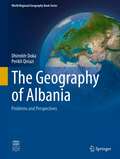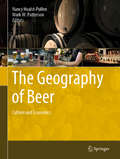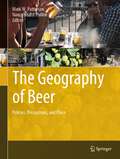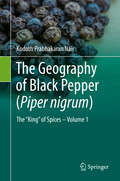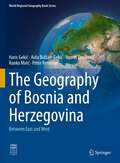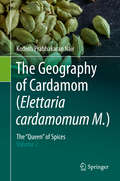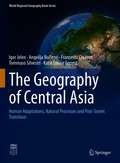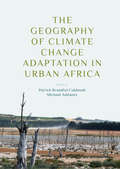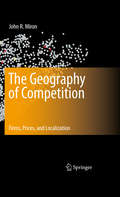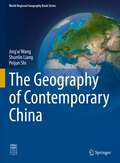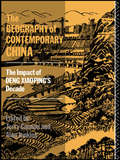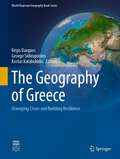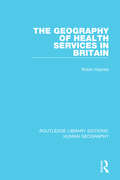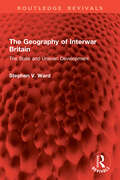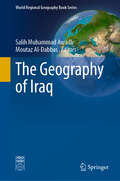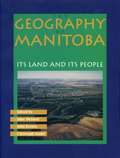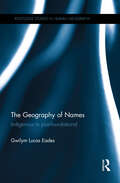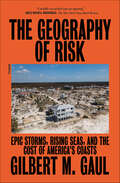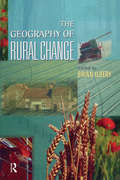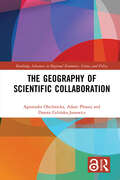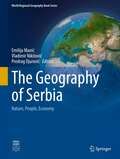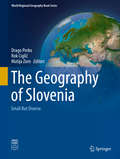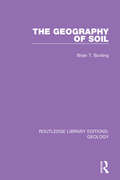- Table View
- List View
The Geography of Albania: Problems and Perspectives (World Regional Geography Book Series)
by Dhimitёr Doka Perikli QiriaziThis book is the first to give a comprehensive and detailed overview of the complete geography of Albania in English. It highlights the most important and manifold potentials of nature, society and economy of Albania as well as development problems during different time periods. One focus lies on Albania's perspectives and challenges for the future.Beside natural aspects also topics such as migration, poverty, social situation, economy, urban development, regional disparities among others are discussed.This book appeals to academics and researchers of geography, regional development and related disciplines as well as teachers and students of geography, geology, natural sciences, social sciences, economics. The book is also attractive for media representatives, tourists and other interested individuals travelling to Albania.
The Geography of Beer: Culture and Economics
by Mark W. Patterson Nancy Hoalst-PullenThis book builds on the highly successful Geography of Beer: Regions, Environment, and Society (2014) and investigates the geography of beer from two expanded perspectives: culture and economics. The respective chapters provide case studies that illustrate various aspects of these themes. As the beer industry continues to reinvent itself and its economic and cultural geographies, this book showcases historical, current, and future trends at the local, regional, national, and international scales.
The Geography of Beer: Policies, Perceptions, and Place
by Mark W. Patterson Nancy Hoalst-PullenThis book focuses on the geography of beer in the contexts of policies, perceptions, and place. Chapters examine topics such as government policies (e.g., taxation, legislation, regulations), how beer and beerscapes are presented and perceived (e.g., marketing, neolocalism, roles of women, use of media), and the importance of place (e.g., terroir of ingredients, social and economic impacts of beer, beer clubs). Collectively, the chapters underscore political, cultural, urban, and human-environmental geographies that underlie beer, brewing, and the beer industry.
The Geography of Black Pepper (Piper nigrum): The "King" of Spices – Volume 1
by Kodoth Prabhakaran NairThis book considers all aspects of black pepper from its growth, as a flowering vine, to how the dried fruit (peppercorn) is used as a spice and traded as a commodity. It is the economic mainstay of several India states and, principally, in Kerala State, with the Indian subcontinent being the largest black pepper producer. Indonesia has also emerged as a large producer of black pepper. Black pepper commands a leading position among the spices and has an immense commercial importance to world trade, finding its way onto the dining table of millions around the world, on the European and North American continents, and Japan. The use of black pepper ranges from a simple dietary component and flavour enhancer, to that of a spice with huge pharmacological benefits.
The Geography of Bosnia and Herzegovina: Between East and West (World Regional Geography Book Series)
by Haris Gekić Aida Bidžan-Gekić Nusret Drešković Ranko Mirić Péter ReményiThis monograph provides a comprehensive overview of fundamental scientific insights into the geographical features of a country which was and still is in the centre of the geopolitical battle of the large world powers and especially neighboring countries. The book presents the scientifically proven reserves of individual resources such as: mineral riches, land, forests, flora and fauna, water and climate features, to the extent needed, through statistical indicators and geographic maps. The authors point to features and specifics of the existing interdependence of economic and political development and impact of natural resources on spatial development which can be useful for potential investors, spatial planers, decision makers, politicians, geographers, students, large Bosnian diaspora and anyone interested in area of Bosnia and Herzegovina. This book fills the gap in geographical literature on Bosnia and Herzegovina in the English language. The monograph appeals to researchers and scholars of all levels in the fields of geography, geopolitics, history and related fields and everyone interested in this country between East and West.
The Geography of Cardamom (Elettaria cardamomum M.): The "Queen" of Spices – Volume 2
by Kodoth Prabhakaran NairThis book catalogues the multi-scale impact of agronomy and economy on Cardamom, known as the “Queen” of spices. Cardamom is the second most important spice crop in the world, after Black pepper, known as the “King” of spices. Spices were the symbols of luxury and royalty, and cardamom was used in the manufacture of perfumes during the Greek and Roman times. It became one of the most important Oriental spices used in both Greek and Roman cuisine as well as its pharmacological applications. The book is divided into 15 chapters and concentrates on aspects of cardamom production and processing, the taxonomic aspects of cardamom, chemistry, pathology, entomology and is concluded with the future of cardamom. Special emphasis is given to the utility of “The Nutrient Buffer Power Concept”, a soil management technique in precise fertilizer management, especially with regard to Potassic fertilizers in cardamom production.
The Geography of Central Asia: Human Adaptations, Natural Processes and Post-Soviet Transition (World Regional Geography Book Series)
by Igor Jelen Angelija Bučienė Francesco Chiavon Tommaso Silvestri Katie Louise ForrestThis book provides a profound geographical description and analysis of Central Asia. The authors take a synthetic approach in a period of critical transformation in the post-soviet time. The monograph analyzes comprehensively the physical and human geography as well as human-nature interactions of Central Asia with focus on Kazakhstan, Uzbekistan, Turkmenistan, Kyrgyzstan and Tajikistan. Natural processes are described at a systemic scale, focusing on ecological impacts and consequences and contemporary human adaptations and organization. It also discusses in which ways the human organizations try to apply solutions for their needs such as security, territorial management and resources renewability, material and functional needs, identity elaborations, culture and communication. The Geography of Central Asia appeals to scientists and students of regional geography and interested academics from other areas such as social, political, economic and environmental studies within the context of Central Asia. The book is also a very useful resource for field trips into this area.
The Geography of Climate Change Adaptation in Urban Africa
by Patrick Brandful Cobbinah Michael AddaneyThis book take a comprehensive look at several cases of climate change adaptation responses across various sectors and geographical areas in urban Africa and places them within a solid theoretical context. Each chapter is a state-of-the-art overview of a significant topic on climate change adaptation in urban Africa and is written by a leading expert in the field. In addition to the focus on the geography of urban adaptation to climate change in Africa, this collection offers a broader perspective by blending the use of case studies and theory based research. It examines transformations in climate change adaptation and its future orientation from the perspectives of urban planners, political economists, environmentalists, ecologists, economists and geographers, thereby addressing the challenges facing African cities adaptation responses from all angles. Providing up-to-date and authoritative contributions covering the key aspects of climate change adaptation in urban Africa, this book will be of great interest to policymakers, practitioners, scholars and students of geography, urban development and management, environmental science and policy, disaster management, as well as those in the field of urban planning.
The Geography of Climate Change Adaptation in Urban Africa
by Patrick Brandful Cobbinah Michael AddaneyThis book takes a comprehensive look at several cases of climate change adaptation responses across various sectors and geographical areas in urban Africa and places them within a solid theoretical context. Each chapter is a state-of-the-art overview of a significant topic on climate change adaptation in urban Africa and is written by a leading expert in the field. In addition to the focus on the geography of urban adaptation to climate change in Africa, this collection offers a broader perspective by blending the use of case studies and theory based research. It examines transformations in climate change adaptation and its future orientation from the perspectives of urban planners, political economists, environmentalists, ecologists, economists and geographers, thereby addressing the challenges facing African cities adaptation responses from all angles. Providing up-to-date and authoritative contributions covering the key aspects of climate change adaptation in urban Africa, this book will be of great interest to policymakers, practitioners, scholars and students of geography, urban development and management, environmental science and policy, disaster management, as well as those in the field of urban planning.
The Geography of Competition
by John R. MironThis book provides a comprehensive, up-to-date, and expert synthesis of location theory. What are the impacts of a firm's geographic location on the locations of customers, suppliers, and competitors in a market economy? How, when, and why does this result in the clustering of firms in space? When and how is society made better or worse off as a result? This book uses dozens of locational models to address aspects of these three questions. Classical location problems considered include Greenhut-Manne, Hitchcock-Koopmans, and Weber-Launhardt. The book reinterprets competitive location theory, focusing on the linkages between Walrasian price equilibrium and the localization of firms. It also demonstrates that competitive location theory offers diverse ideas about the nature of market equilibrium in geographic space and its implications for a broad range of public policies, including free trade, industrial policy, regional development, and investment in infrastructure. With an extensive bibliography and fresh, interdisciplinary approach, the book will be an invaluable reference for academics and researchers with an interest in regional science, economic geography, and urban planning, as well as policy advisors, urban planners, and consultants.
The Geography of Contemporary China (World Regional Geography Book Series)
by Peijun Shi Shunlin Liang Jing’ai WangThis textbook provides a comprehensive and very detailed insight into Chinese Contemporary Geography in English. It documents the geographical issues associated with China's rapid growth. Since initiating the reforms and open policy, China has achieved tremendous success. China's rapid growth is now a driving force in the global economy and is achieving unprecedented rates of poverty reduction. However, China also faces a number of sustainability and emerging challenges associated with rapid growth such as growing regional disparities in terms of per capita income and social-economic development, sustainable resource development, and issues related to regional and global economic integration. In addition, rapid economic growth has also brought about major challenges such as resource shortages, ecological and environmental destruction, land degradation and frequent disasters. This book presents the authors’ reflections. This lavishly illustrated book covers physical geography, history, and economic and political systems of the world's most populous country. The major focus is on geographical issues in China's contemporary development: agriculture, population, urbanization, resource and energy, and environment. The lead author of the book has taught relevant courses in China for three decades, and authored and edited multiple textbooks for Chinese students. This book will appeal to undergraduate students of geography and related disciplines with a regional focus on China and to the general reader who wants to learn different geographical aspects of modern China with little academic background in geography.
The Geography of Contemporary China: The Impact of Deng Xiaoping's Decade
by Terry Cannon Alan JenkinsDeng Xiaoping's rule has seen fundamental economic change in China. This book considers the impact of these years on China's physical environment, as well as its people, industry, agriculture and trade. It also assesses the contribution of a decade of Chinese politics towards geopolitics. The book provides an introduction to Communist China, setting its spatial and environmental themes in the historical, political and economic framework so crucial to a proper understanding of this country and the fifth of the world's population it contains. It is particularly suited to courses on China, its geography and development strategy. After the bloody events of Tiananmen Square in June 1989 China's geopolitics will continue to hold the world's attention. With this in view the book also provides guides to further reading.
The Geography of Greece: Managing Crises and Building Resilience (World Regional Geography Book Series)
by Régis Darques George Sidiropoulos Kostas KalabokidisDuring the last few years, Greece has become a subject of increasing attention worldwide. Once praised for its ability to innovate and reform during the EU integration process, applauded for its remarkable job in managing the 2004 Olympics, the country fell into a financial crisis of unprecedented magnitude in 2008. Much has been said on this matter, and amid the morass of information a staggering number of untruths have been disseminated.In fact, the challenges of vulnerability and the paradigms of adaptation go way beyond finance and economy in Greece. Mega-fires, earthquakes, landslides and floods, migrations, sociopolitical upheavals, and armed conflicts generate emergency situations repeatedly. Because of its bridging role between natural and social sciences, geography can provide insights into the entire breadth of hazardous and chaotic events driving adaptation and change. Against all these threats, Greece has developed an enhanced resilience capacity. The purpose of this book is to help unravel the complexities of a fascinating country beyond clichés.This book is intended for students, researchers, scholars, and engineers interested in geography, land planning, urban studies, and environmental management. The crises issue intended as a guideline allows widening the audience to include the media, governmental and non-governmental agencies, and the public at large.
The Geography of Health Services in Britain. (Routledge Library Editions: Human Geography #9)
by Robin HaynesThis book is about geographical variation in the organisation, provision and use of health services in Britain. Its main theme is that neither the quantity nor the quality of health care provided by the National Health Service (NHS) is uniform from place to place. Chapters discuss and evaluate: The reorganisation of the NHS in the years up to 1987 The relationships between the need for health care and the supply of health services The redistribution of health service resources geographically The distribution of doctors, dentists, community nurses and hospitals across the UK Access to health services The distribution of both private health facilities and social welfare services and their effect on the NHS.
The Geography of Interwar Britain: The State and Uneven Development (Routledge Revivals)
by Stephen V. WardAs the first geographical study of interwar Britain, The Geography of Interwar Britain (originally published in 1988 and now with a new preface by the author) breaks new ground, incorporating original research and new interpretations of the work of historians and others within a geographical frame of reference.The central argument of the book is that the state in interwar Britain intensified uneven capitalist development. State actions in many important fields, including macro-economic policy, defence, industrial rationalisation, labour and unemployment policy, local government and regional policy, are analysed in detail. These studies show that, until the later 1930s, state policies worked to the disadvantage of depressed ‘outer’ Britain and favoured the more prosperous south and midlands. However, shifts in state policies were apparent as rearmament and changes in macro-economic policies necessitated new approaches. Significantly the first stages in the creation of what became the post-1945 political consensus were evident at this time, particularly in regional and industrial location policy.The book will be of interest to geographers, economic and social historians, political scientists, sociologists, and planners.
The Geography of Iraq (World Regional Geography Book Series)
by Salih Muhammad Awadh Moutaz Al-DabbasHuman civilization first emerged in ancient Mesopotamia, where the first writing and the first technologies originated. Writing about Mesopotamia the Cradle of Civilization (the land between the rivers, the Tigris and Euphrates Rivers, modern-day Iraq) is interesting for all interesting readers in the world. Iraq is one of the most beautiful, diverse, and impressive countries in the world. Iraq has a diverse range of environments, landscapes, inhabitants, activities, and cultural heritage, and human civilization has a lot to offer. An extensive collection of original materials gathered over the past few decades was used to elaborate on the geography of Iraq in a novel-length book. The geography of Iraq includes detailed information on its physical, human, economic, historical, and environments. Readers, students, and teachers from all over the world who seek out this information will be satisfied with the various figures, maps, and photographs due to the extra value added.
The Geography of Manitoba: Its Land and its People
by Christoph Stadel John Welsted John EverittManitoba is more than one of Canada's three prairie provinces. Encompassing 649,950 square kilometres, its territory ranges from Canadian Shield to grassland, parkland, and subarctic tundra. Its physical geography has been shaped by ice-age glaciers, while its human geography reflects the influences of its various inhabitants, from the First Nations who began arriving over 9,000 years ago, to its most recent immigrants. This fascinating range of geographical elements has given Manitoba a distinct identity and makes it a unique area for study. Geography of Manitoba is the first comprehensive guide to all aspects of the human and physical geography of this unique province. Representing the work of 47 scholars, and illustrated with over 200 maps, diagrams, and photographs, it is divided into four main sections, covering the major areas of the province's geography: Physical Background; People and Settlements; Resources and Industry; and Recreation.As well as studying historical developments, the contributors to Geography of Manitoba analyse recent political and economic events in the province, including the effect of federal and provincial elections and international trade agreements. They also comment on future prospects for the province, considering areas as diverse as resource management and climatic trends.
The Geography of Names: Indigenous to post-foundational (Routledge Studies in Human Geography)
by Gwilym Lucas EadesThis book examines geographical names, place-names, and toponymy from philosophical and cultural evolutionary perspectives. Geographical name-tracking-networks (Geo-NTNs) are posited as tools for tracking names through time and across space, and for making sense of how names evolve both temporally and spatially. Examples from North and South American indigenous groups, the Canadian arctic, Wales, England, and the Middle East are brought into a theoretical framework for making sense of aspects of place-naming practices, beliefs, and systems. New geographical tools such as geographic information systems (GIS) and global positioning systems (GPS) are demonstrated to be important in the production and maintenance of robust networks for keeping names and their associated meanings viable in a rapidly changing world where place-naming is being taken up increasingly in social media and other new mapping platforms. The Geography of Names makes the case that geographical names are transmitted memetically (i.e. as cultural units, or memes) through what Saul Kripke called communication chains. Combining insights from Kripke with views of later Wittgenstein on language and names as being inherently spatial, the present work advances theories of both these thinkers into an explicitly geographical inquiry that advances philosophical and practical aspects of naming, language, and mapping.
The Geography of Nowhere: The Rise and Decline of America's Man-Made Landscape
by James Howard KunstlerThis book traces the development of modern American car culture and the architecture and social life of cities and suburbs that developed around it.
The Geography of Risk: Epic Storms, Rising Seas, and the Cost of America's Coasts
by Gilbert M. GaulThis century has seen the costliest hurricanes in U.S. history—but who bears the brunt of these monster storms?Consider this: Five of the most expensive hurricanes in history have made landfall since 2005: Katrina ($160 billion), Ike ($40 billion), Sandy ($72 billion), Harvey ($125 billion), and Maria ($90 billion). With more property than ever in harm’s way, and the planet and oceans warming dangerously, it won’t be long before we see a $250 billion hurricane. Why? Because Americans have built $3 trillion worth of property in some of the riskiest places on earth: barrier islands and coastal floodplains. And they have been encouraged to do so by what Gilbert M. Gaul reveals in The Geography of Risk to be a confounding array of federal subsidies, tax breaks, low-interest loans, grants, and government flood insurance that shift the risk of life at the beach from private investors to public taxpayers, radically distorting common notions of risk.These federal incentives, Gaul argues, have resulted in one of the worst planning failures in American history, and the costs to taxpayers are reaching unsustainable levels. We have become responsible for a shocking array of coastal amenities: new roads, bridges, buildings, streetlights, tennis courts, marinas, gazebos, and even spoiled food after hurricanes. TheGeography of Risk will forever change the way you think about the coasts, from the clash between economic interests and nature, to the heated politics of regulators and developers.
The Geography of Rural Change
by Brian IlberyThe Geography of Rural Change provides a thorough examination of the processes and outcomes of rural change as a result of a period of major restructuring in developed market economies. After outlining the main dimensions of rural change, the book progresses from a discussion of theoretical insights into rural restructuring to a consideration of both the extensive use of rural land and the changing nature of rural economy and society. The text places an emphasis on relevant principles, concepts and theories of rural change, and these are supported by extensive case study evidence drawn from different parts of the developed world.The Geography of Rural Change is written for undergraduates taking courses in human geography, agricultural geography, rural geography, rural sociology, planning and agricultural economics.
The Geography of Scientific Collaboration (Routledge Advances in Regional Economics, Science and Policy)
by Agnieszka Olechnicka Adam Ploszaj Dorota Celińska-JanowiczScience is increasingly defined by multidimensional collaborative networks. Despite the unprecedented growth of scientific collaboration around the globe – the collaborative turn – geography still matters for the cognitive enterprise. This book explores how geography conditions scientific collaboration and how collaboration affects the spatiality of science. This book offers a complex analysis of the spatial aspects of scientific collaboration, addressing the topic at a number of levels: individual, organizational, urban, regional, national, and international. Spatial patterns of scientific collaboration are analysed along with their determinants and consequences. By combining a vast array of approaches, concepts, and methodologies, the volume offers a comprehensive theoretical framework for the geography of scientific collaboration. The examples of scientific collaboration policy discussed in the book are taken from the European Union, the United States, and China. Through a number of case studies the authors analyse the background, development and evaluation of these policies. This book will be of interest to researchers in diverse disciplines such as regional studies, scientometrics, R&D policy, socio-economic geography and network analysis. It will also be of interest to policymakers, and to managers of research organisations.
The Geography of Serbia: Nature, People, Economy (World Regional Geography Book Series)
by Emilija Manić Vladimir Nikitović Predrag DjurovićThis is a comprehensive regional geography synthesis of the most important physical and human spatial processes that shaped Serbia and led to many interesting regional issues, not only to Serbia but to the Balkans and Europe. The book provides an overall view on the Serbian physical environment, its population and economy. It also highlights important regional issues such as regional disparities and depopulation, sustainable development and ecological issues and rural economy in the context of rural area development, which have been shaped by different political and historical processes. This highly illustrated book provides interesting and informative insights into Serbia and its context within the Balkans and Europe. It appeals to scientists and students as well as travelers and general readers interested in this region.
The Geography of Slovenia: Small But Diverse (World Regional Geography Book Series)
by Drago Perko Rok Ciglič Matija ZornThis book is the first to give a comprehensive and detailed overview of the complete geography of Slovenia in English. Only very few countries, even considerably larger ones, can boast the landscape diversity found in Slovenia since the Alps, the Pannonian Basin, the Dinaric Alps, and the Mediterranean meet and interweave in this small corner of Central Europe, as do Germanic, Hungarian, Slavic, and Romance cultural influences. The book provides a systematical overview of physical and human geographical elements of Slovenia from landforms to cultural characteristics. Special attention is given to landscape diversity, to the presentation of Slovene landscape types and regions, to some particularities and interesting facts of Slovenia, and to the position of Slovenia in the World. The book also illustrates some other important geographical phenomena, processes and interactions between nature and society in nowadays Slovenia. This volume appeals to researchers as well as students in the field of regional geography. It can also serve as a source for complete background information as well as a field guide for Slovenia.
The Geography of Soil (Routledge Library Editions: Geology #10)
by Brian T. BuntingThis book, first published in 1965, was the first by a British soil expert in which he wrote a study of his subject from a geographical, not an agricultural or biological, viewpoint. Chapters 1-8 deal with the factors and processes in soil formation. Chapters 9-17 describe the soil groups of the different regions of the world – for example, desert and tundra, the boreal zone, the Mediterranean, and intertropical areas.
